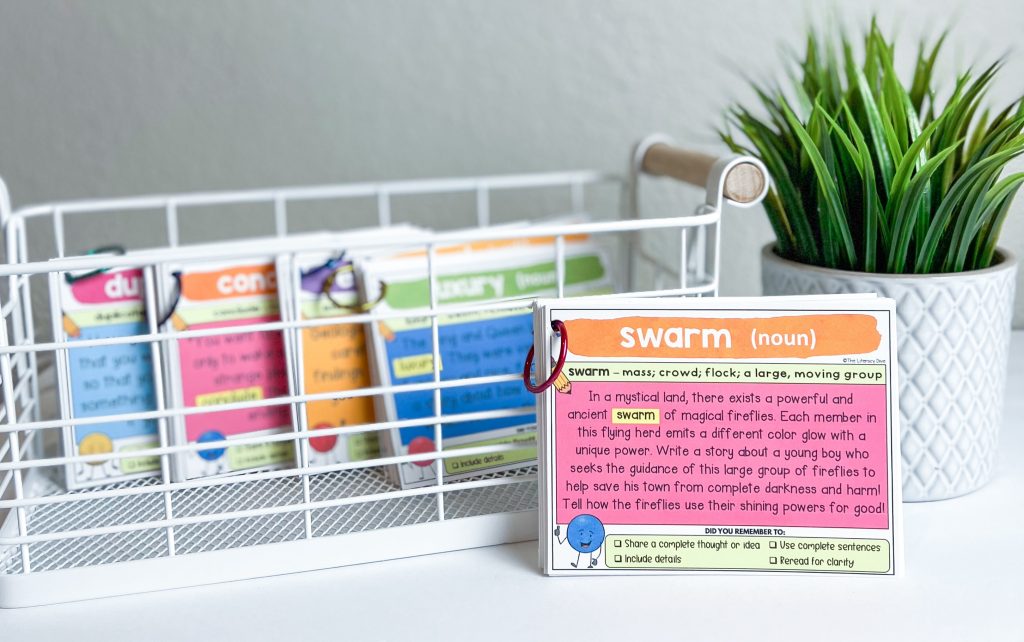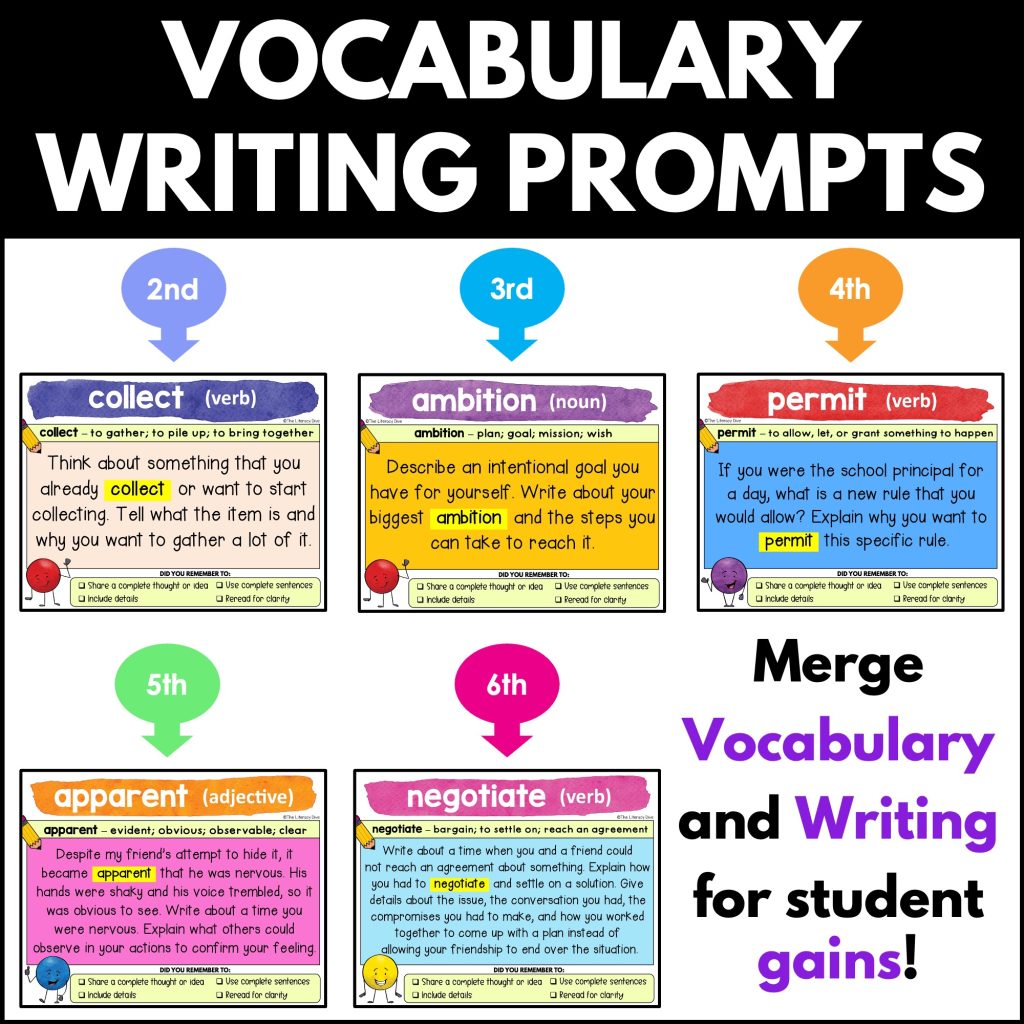
Debunking Myths! 4 Common Vocabulary Acquisition Misconceptions
Vocabulary acquisition is a crucial part of education, but it often comes with a set of myths and misconceptions that hinder effective instruction. Misconceptions surrounding vocabulary instruction have been floating around for ages, creating unnecessary hurdles for children. Only relying on our students reading texts, or implementing a weekly vocabulary test where students have to match 5-10 words to definitions is not going to be the key to students acquiring vocabulary.
Let’s chat about disproving some myths! In particular, 4 common vocabulary misconceptions, highlighting the need for intentional instruction, and ensuring that you are incorporating different ways to embed vocabulary outside of the standard way. If you are a podcast listener and prefer to listen to a more detailed conversation, click here to hear episode 146 on The Literacy Dive Podcast.
Think about your experience with misconceptions no matter when, where, or how they occurred. These misconceptions probably left you feeling a certain way (positively or negatively). They may have left you confused, worried, or troubled. These misconceptions may have left you confident, secure, and convinced.
When it comes to comprehending an entity as robust as vocabulary, it is important to do extra research. This will prevent myths from becoming out reality.
These myths and misconceptions around vocabulary are important to tackle because if we hold on to everything we have heard or read as true without researching and fact-checking, then we will find ourselves doing, or NOT doing, a certain action or practice. While there are many, many misconceptions, we are going to dive into four myths.
Vocabulary Misconceptions #1: Reading alone will suffice for vocabulary growth.
Out of all of the vocabulary misconceptions out there, the first major myth is that reading is sufficient enough to expand our students’ vocabularies. While reading is an incredible vehicle for learning, having students depend on it solely for growing their vocabulary can be like expecting to become a chef just by eating food. It is not that simple.
A chef has to interact with the different spices, fruits, vegetables, meats, and so forth and know their properties to know if a certain cuisine is going to be desired by others – the meal has to make sense, you know? A chef has studied the ins and outs of each item used and from that in-depth understanding, can make an award-winning menu. Students need more than just reading words inside of a book.
For example, imagine your student reading and stumbling upon the word “ephemeral” in a book. Without proper guidance or context, they might gloss over it, missing out on a beautiful word that describes something fleeting, or lasting for a very short time. While reading exposes students to words, it’s the rich discussions, focused instruction, and usage that embed those words into memory. So, while reading is a critical component, it’s just one place vocabulary lives. Implicit instruction is still needed for vocabulary acquisition!
Vocabulary Misconceptions #2: Memorization equals mastery.
Next on the list of common vocabulary misconceptions involves memorizing. It’s time for a reality check on the word “memorization”. I am sharing this because, in my early teaching years, I truly didn’t know better and figured a vocabulary quiz, much like spelling, was enough. What ends up happening is students will make 100% on a Friday quiz, but two weeks later not know the meaning of a word when they see it in a different context. This proves that memorization does not equate to comprehension.
Memorization isn’t the solution for vocabulary acquisition. Rote memorization doesn’t engage the brain’s understanding and ability to make connections. For instance, a student might remember the definition of “camouflage” but truly grasping its meaning requires seeing it in nature, using it in writing, and discussing its function. True mastery is when a student can use the word appropriately in various contexts, not just recite its meaning!
Vocabulary Misconceptions #3: Learning vocabulary in isolation will result in retention.
How many times can you say that you learned a word best when it was all alone by itself? Can you admit that learning it in isolation was the best way for you to maintain the highest level of comprehension around it? You might not be able to think of a time or admit that this is true and that might be because anything you acquired new vocabulary, it was probably beneficial and helpful to have it accompanied by context.
If you have heard the phrase, “context is king”, there is a really good reason for it. I can absolutely recall and think back to several times I took something out of context because I was not comprehending the full meaning of a phrase or statement that was stated to me. Context really is king and contextual learning is critical.
Let’s say a student encounters the word “arduous” in isolation. All by itself it might feel abstract, even confusing. If you can provide context for that word, it will be much less confusing. What I am going to do is place that word into a sentence.
“The mountain climb was arduous.”
Suddenly, the word takes form and shape, hinting at a challenging task. Something that is strenuous, difficult, taxing, and exhausting… we get to arrive at this meaning because of our background knowledge, understanding, and interactions we may have heard, seen, or experienced with mountain climbing. So in this instance, context breathes life into vocabulary, making abstract terms tangible. This is beyond helpful and necessary for students as they strengthen their muscles of attaining vocabulary.
Make it a goal that the next time you introduce a word to students, weave it into stories, discussions, and examples. This will make new vocabulary memorable and meaningful.
Vocabulary Misconceptions #4: If students can recognize a word, they have acquired it.
When it comes to vocabulary, there is a world of difference between “knowing” a word and “using” it. Think of it as the difference between having a beautiful instrument and actually playing it. There really is a difference between the two actions. This relates to passive vs. active vocabulary.
Passive vocabulary refers to words that students recognize when they read or hear them. Active vocabulary, on the other hand, is the set of words students confidently use in writing and speaking. It is all about the application which is a higher level skill than just remembering, and moving from passive to active vocabulary is where true vocabulary acquisition occurs.
For instance, students may understand the word “elusive” in a story, but they need to actively use it in everyday language to truly master it. Encouraging students to apply new words in daily conversations, explanations, and writing is the key to bridging the gap between knowing and using vocabulary.
I love examples so here is another one. A student might understand “elusive” when they come across it in a story by using context clues, but do they use that word to describe their pet cat’s behavior at home? Elusive means difficult to catch or find; hard to track down. So trying to catch a cat, mouse, or fly is not easy because they are quick and elusive. They are tough to catch. Fish and rabbits are pretty speedy so they are elusive, too! So ensuring this transition from passive to active vocabulary is where the focus should be and where true vocabulary acquisition is achieved.
You can help by being intentional in your communication with students. Use the vocabulary you are teaching them in your own dialogue as that will strengthen their comprehension and proficiency.
Try this freebie!
Try these 5 free vocabulary writing prompts as a way to bring vocabulary exposure and application into your classroom in 2nd – 6th-grade classrooms. Allow your students to practice two meaningful skills at the same time!
… or grab a grade-level set!



If you are looking for a solid vocabulary + writing routine, check out these vocabulary writing prompt grade-level sets! Find specific vocabulary sets for

Great for differentiation and language exposure!
Let’s get past these (and other) myths and misconceptions that have been circulating for years. It’s simple. Vocabulary needs more than just exposure – it needs intentional instruction with application as the end result. I want you to remember that context is king, meaning words are best learned in meaningful contexts and not just in the action of reading. We have to strive for vocabulary usage, not just memory.
Your big takeaway: A strong vocabulary does not come automatically. There is an important need for structured vocabulary instruction and making sure you are incorporating vocabulary in different ways.
Let’s be intentional about integrating new words into stories, discussions, and assignments, along with encouraging our students to incorporate them into their daily communication. Every single word is a gateway, a story, a tool. Let’s ensure our students not only “know” these tools but can “use” them with power and confidence. You got this!
Share it:
- Read more about: Reading, Teacher Tips, Vocabulary
You might also like...

Hey, I'm Megan!
I am a literacy specialist and curriculum designer who loves sharing tips and ideas to help students thrive in literacy! It brings me joy to await those a-ha moments and to see light bulbs turn on!
I have a huge passion for reading and writing and love to co-mingle the two any chance I get! You can expect to learn new strategies and ways to keep your students engaged during your literacy block! I am so glad you’re here!





